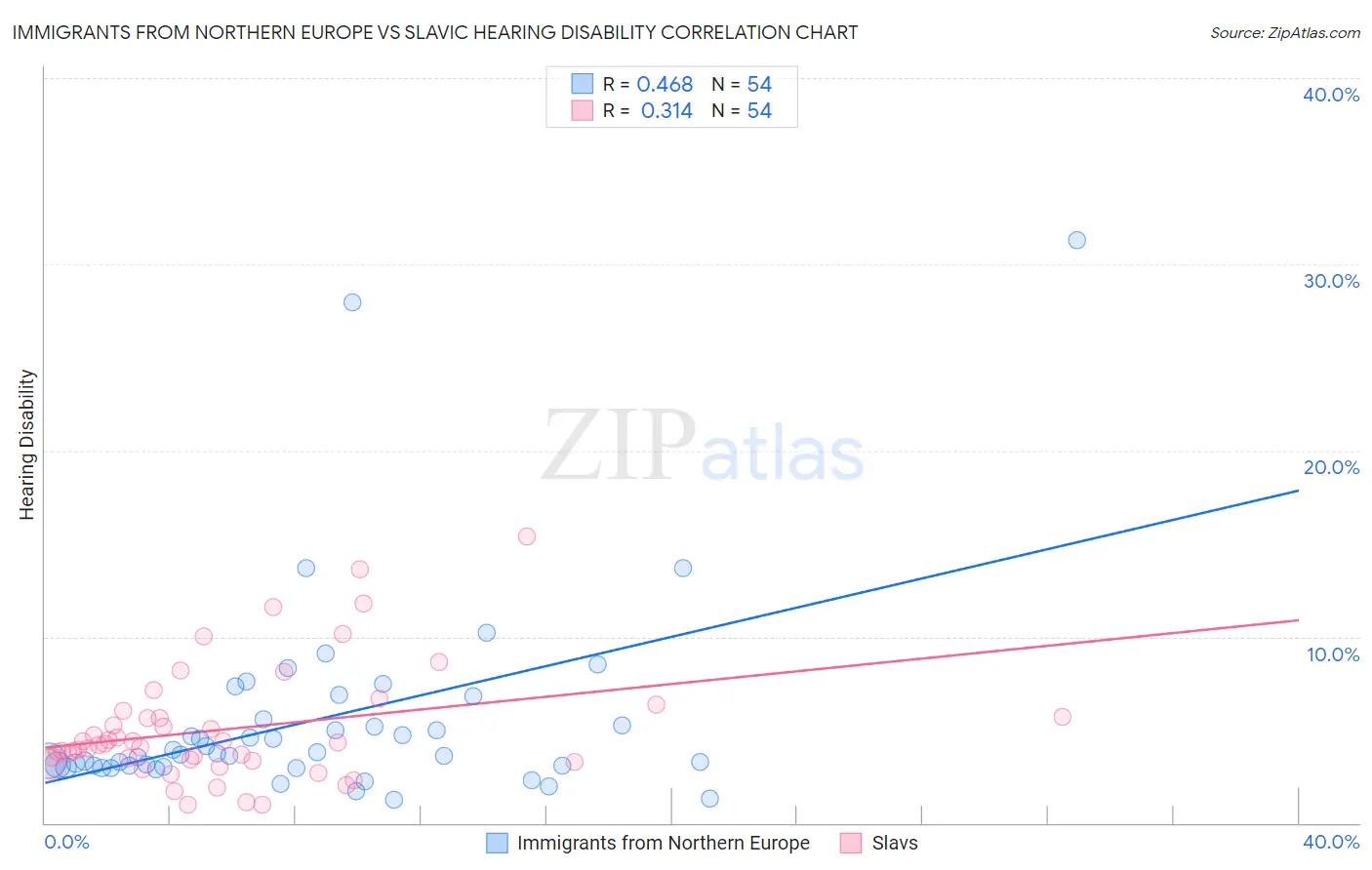Immigrants from Northern Europe vs Slavic Hearing Disability
COMPARE
Immigrants from Northern Europe
Slavic
Hearing Disability
Hearing Disability Comparison
Immigrants from Northern Europe
Slavs
3.2%
HEARING DISABILITY
7.0/ 100
METRIC RATING
218th/ 347
METRIC RANK
3.4%
HEARING DISABILITY
0.2/ 100
METRIC RATING
254th/ 347
METRIC RANK
Immigrants from Northern Europe vs Slavic Hearing Disability Correlation Chart
The statistical analysis conducted on geographies consisting of 477,037,225 people shows a moderate positive correlation between the proportion of Immigrants from Northern Europe and percentage of population with hearing disability in the United States with a correlation coefficient (R) of 0.468 and weighted average of 3.2%. Similarly, the statistical analysis conducted on geographies consisting of 270,835,227 people shows a mild positive correlation between the proportion of Slavs and percentage of population with hearing disability in the United States with a correlation coefficient (R) of 0.314 and weighted average of 3.4%, a difference of 7.7%.

Hearing Disability Correlation Summary
| Measurement | Immigrants from Northern Europe | Slavic |
| Minimum | 1.2% | 0.96% |
| Maximum | 31.3% | 15.4% |
| Range | 30.1% | 14.4% |
| Mean | 5.6% | 5.0% |
| Median | 3.7% | 4.2% |
| Interquartile 25% (IQ1) | 3.1% | 3.3% |
| Interquartile 75% (IQ3) | 5.5% | 5.7% |
| Interquartile Range (IQR) | 2.5% | 2.4% |
| Standard Deviation (Sample) | 5.5% | 3.1% |
| Standard Deviation (Population) | 5.4% | 3.1% |
Similar Demographics by Hearing Disability
Demographics Similar to Immigrants from Northern Europe by Hearing Disability
In terms of hearing disability, the demographic groups most similar to Immigrants from Northern Europe are Russian (3.2%, a difference of 0.040%), New Zealander (3.2%, a difference of 0.060%), Immigrants from Norway (3.2%, a difference of 0.12%), Malaysian (3.2%, a difference of 0.12%), and Immigrants from Laos (3.2%, a difference of 0.12%).
| Demographics | Rating | Rank | Hearing Disability |
| Romanians | 12.1 /100 | #211 | Poor 3.1% |
| Pakistanis | 11.1 /100 | #212 | Poor 3.1% |
| Immigrants | Iraq | 10.5 /100 | #213 | Poor 3.1% |
| Australians | 8.1 /100 | #214 | Tragic 3.2% |
| Bangladeshis | 8.1 /100 | #215 | Tragic 3.2% |
| Immigrants | Norway | 7.3 /100 | #216 | Tragic 3.2% |
| Russians | 7.1 /100 | #217 | Tragic 3.2% |
| Immigrants | Northern Europe | 7.0 /100 | #218 | Tragic 3.2% |
| New Zealanders | 6.8 /100 | #219 | Tragic 3.2% |
| Malaysians | 6.6 /100 | #220 | Tragic 3.2% |
| Immigrants | Laos | 6.6 /100 | #221 | Tragic 3.2% |
| Immigrants | Oceania | 6.5 /100 | #222 | Tragic 3.2% |
| Mexicans | 5.6 /100 | #223 | Tragic 3.2% |
| Icelanders | 5.2 /100 | #224 | Tragic 3.2% |
| Latvians | 5.1 /100 | #225 | Tragic 3.2% |
Demographics Similar to Slavs by Hearing Disability
In terms of hearing disability, the demographic groups most similar to Slavs are Polish (3.4%, a difference of 0.23%), Hmong (3.4%, a difference of 0.27%), Carpatho Rusyn (3.4%, a difference of 0.42%), Yaqui (3.4%, a difference of 0.73%), and Northern European (3.4%, a difference of 0.79%).
| Demographics | Rating | Rank | Hearing Disability |
| Lithuanians | 0.6 /100 | #247 | Tragic 3.4% |
| Austrians | 0.6 /100 | #248 | Tragic 3.4% |
| Italians | 0.4 /100 | #249 | Tragic 3.4% |
| Yuman | 0.4 /100 | #250 | Tragic 3.4% |
| Hungarians | 0.4 /100 | #251 | Tragic 3.4% |
| Croatians | 0.4 /100 | #252 | Tragic 3.4% |
| Carpatho Rusyns | 0.3 /100 | #253 | Tragic 3.4% |
| Slavs | 0.2 /100 | #254 | Tragic 3.4% |
| Poles | 0.2 /100 | #255 | Tragic 3.4% |
| Hmong | 0.2 /100 | #256 | Tragic 3.4% |
| Yaqui | 0.2 /100 | #257 | Tragic 3.4% |
| Northern Europeans | 0.2 /100 | #258 | Tragic 3.4% |
| Slovenes | 0.1 /100 | #259 | Tragic 3.5% |
| Portuguese | 0.1 /100 | #260 | Tragic 3.5% |
| Hawaiians | 0.1 /100 | #261 | Tragic 3.5% |